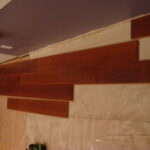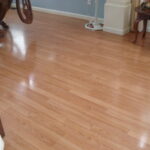Replacing the flooring in your home can be a costly venture. Opting to do the work yourself, can save you hundreds of dollars over hiring professional installers. I recently did this myself in my living room; granted, I did it over a three-day period and my home was in a state of disarray (even more so than normal). By doing the work myself, I was able to redo my living room floor for less than $300.00. I am going to share with you what I did and how I did it so that you too, can have a new floor at a low price.
I made the decision that the carpet had to go, I like the look of hardwood floors, but I do not like the maintenance and the cost that goes along with it. After doing a bit of research, I opted to purchase glueless laminate flooring, sometimes known as Pergo, which is a brand name. This type of flooring is considered a ‘floating floor’ and fits together using a tongue and groove.
I shopped around at several different home stores, beginning with a “surplus” store. The “surplus” store had the best prices; however, I found that the quality of the laminate flooring was not as good as I had hoped. The laminate flooring seemed a little flimsy, and when attempting to join the sample pieces available the seam was noticeable. I then went to Home Depot, the comparable product there was about 10 cents higher per square foot than the “surplus” store, but the quality was noticeably better. Not wanting to make a purchase until I had checked at least one more store, I drove down the street to Lowe’s where I found the quality and price to be very similar to that of Home Depot. I decided to make my purchase from Lowe’s.
What you should do before you shop for glueless laminate flooring
Before you head out to the nearest home store to purchase laminate flooring you should do a few things to prepare for your purchase. The most important thing you should do is calculate exactly how much flooring you will need. To get this figure simply measure the length and the width of your room and multiply the two numbers together. This will give you the square footage of the room.
After you get the square footage of the room, you will need to decide whether you will need to replace your baseboard. Some rooms that are currently carpeted do not have baseboard, if this is the case in your room, you will want to make plans to purchase baseboard. I found pre-finished baseboards in eight-foot sections at Lowe’s for under $4.00 each. The room I re-floored has fourteen-foot walls by sixteen-foot walls. Five eight-foot baseboards are plenty to complete the room.
You will also need to determine whether you plan to remove your current flooring or install the laminate flooring on top of it. Linoleum and low-pile carpets can remain on the floor while shag carpets and high-pile carpets should be removed.
Things you need to install your glueless laminate flooring
A few tools that can be found in most garages and workshops are needed to aide your installation of glueless laminate flooring. The most important tool you will need is a measuring tape. If you do not have a measuring tape, a yardstick or even a ruler will work in pinch. You will use the measuring tape to mark the boards for cutting them to fit your room.
You will also need a jigsaw or a skill saw. If you do not have either of these items you can use a handsaw, however the electric saws will cut your work time and make the work much easier. If you use a jigsaw, be sure that you use a blade that is designed to cut wood. Using blades that are designed to cut metal or tile will result in your laminate flooring having jagged edges and can sometimes scar the finish.
A hammer is needed to help join the pieces together. A rubber mallet is preferred however if you do not have one of these, a regular claw hammer will work. You will need to use care when using a claw hammer as it is possible to damage the finish.
A kit is available which includes a universal tapping block and a pull bar. These items are designed to fit on the ends and sides of the laminate flooring and used to join the pieces together tightly. The tapping block has a lip that fits on the edge; you tap the block against the laminate flooring to join the pieces together. The pull bar is excellent for pulling pieces from the edge of a wall, where the tapping block will not fit. I recommend you purchase at the very least the pull bar. The tapping block can be substituted with a piece of wood that is cut in small rectangle, however if you use this method, be very careful as you can damage the tongue and groove when joining the pieces together.
You may also need an underlay. If you have linoleum or a floor that will be removed prior to the install of your laminate flooring, you will need an underlay. This is often a very thin piece of foam or plastic with foam balls attached. This enables the floor to ‘float’ as it is designed to do.
Choosing your laminate flooring
Choosing your laminate flooring can be difficult. There are many choices and many price ranges. During my shopping, I discovered that prices range from .79 cents up to $3.95 per square foot. I did notice that in come cases the more expensive laminate flooring was no better in quality than the lower priced laminate flooring. When you are shopping for the laminate flooring for your room, you need to consider several factors. Price is often one of the most important factors. I chose a low-priced laminate flooring, but I did not choose the cheapest. The laminate flooring I chose came in a color I liked and had a 10-year warranty.
Quality is another important factor. Retailers often have at least two sample pieces for your inspection. You should handle these pieces, check to see if they are sturdy, and fit together properly. You should make sure that they are not flimsy and feel as if they could break easily.
Laminate flooring is sold by the square foot in most cases. Each box of laminate flooring will be printed with the total square footage contained in the box. I recommend that you purchase fifteen to twenty square foot more than you need to allow for any mistakes that you might make. This will prevent a trip back to the store if you happen to cut the wrong end or damage another piece during cutting.
Installing your laminate flooring
If you are leaving your low pile carpet on the floor, you can begin your installation immediately. If you need to install the underlay, you will need to roll it out onto the floor following the manufacturer’s directions.
Now that you have everything you need, it is time to install your laminate flooring. If you are like me, you have limited time, so it is acceptable to do this in a few days time, however you may irritate family members with the state of your room. Gather all your tools together and begin in a corner of the room. Place one piece in the corner and work your way outward. The first piece can be joined at the end with the second piece, then the third piece should be the first piece in your second row. Use your tapping block to join the pieces, and the pull bar to pull the end pieces together. Continue in this method all the way down the wall. Once you come to the end and need to trim a piece to fit, use your measuring tape to measure and mark where your cut will need to be made. Make your cut as smoothly as possible to avoid jagged edges. Once you reach the end, you can begin from that end and work your way back to where you started joining rows three and four. Continue this through your entire floor.
Installing the pieces together seamlessly can be frustrating. Hold the piece at a 90 degree angle and bring it down to about 45 degrees. Line up the tongue and groove and use your hammer and tapping block to join the pieces correctly.
You will find that depending on the shape of your room that you may need to trim around molding and edges to ensure a snug fit. When you are installing your floor, you should leave approximately ¼-inch space between the flooring and the wall to allow for expansion.
Once you have your laminate flooring installed and joined together, you may find that you will need to do a little additional tapping to insure that the pieces fit together properly. This is frustrating, but normal, until you install your baseboard. The installation of the baseboard will require measuring and cutting of the end pieces to the appropriate size. Make smooth cuts that will join the pieces together seamlessly.
The last thing you will need to do is check your seam areas where the flooring joins another room. You will need to purchase a seam strip to blend the two areas. These are easily installed but can be expensive, shop around before you make your purchase.
Once you have your flooring installed, step back, and admire the professional job you have just done. It looks great and you saved a bundle by doing it yourself.
If you found this article useful and would like to read more by this author, click on her name at the top of this page.




